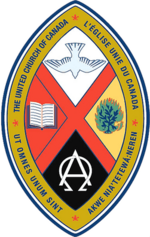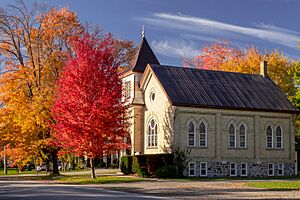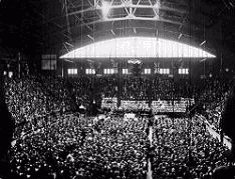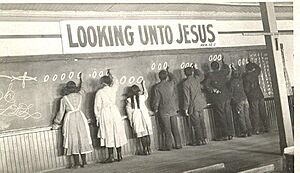United Church of Canada facts for kids
Quick facts for kids United Church of Canada |
|
|---|---|

The official seal of the United Church of Canada
|
|
| Abbreviation | UCC, EUC |
| Type | United church |
| Classification | Mainline Protestant |
| Orientation | Methodist and Reformed |
| Scripture | Protestant Bible |
| Polity | Presbyterian |
| General Secretary | Michael Blair |
| Moderator | Carmen Lansdowne |
| Associations |
|
| Region | Canada (plus Bermuda) |
| Origin | June 10, 1925 Mutual Street Arena, Toronto, Ontario |
| Merger of |
|
| Absorbed | Canadian Conference of the Evangelical United Brethren Church (1968) |
| Congregations | 2,451 |
| Members | 325,315 registered (baptized) members |
The United Church of Canada (UCC) is a major Protestant Christian denomination in Canada. It is the largest Protestant church and the second-largest Christian church in the country, after the Catholic Church in Canada.
The United Church was created in 1925 when four different Protestant groups decided to join together. These were the Methodist Church, the Congregational Union of Ontario and Quebec, most of the Presbyterian Church in Canada, and the Association of Local Union Churches. When they merged, they had about 600,000 members. Later, in 1968, the Evangelical United Brethren Church also joined.
The church's membership was highest in 1964, with over one million members. According to the 2021 Canadian census, about 1.2 million Canadians said they belonged to the United Church.
The United Church is known for its inclusive and liberal policies. For example, it allows anyone, regardless of gender or marital status, to become a minister. It also recognizes marriages between people of different faiths.
Contents
History of the Church
In the early 1900s, many small Canadian towns had separate Methodist, Presbyterian, and Congregational churches. This made it hard to find enough ministers, especially in the prairie provinces. So, a movement began to unite these churches into one.
Not everyone agreed. A minority of Presbyterians decided not to join the new church. They formed their own "continuing" Presbyterian Church in Canada.
A New Church is Born
The United Church of Canada was officially formed on June 10, 1925, at a large service in Toronto's Mutual Street Arena. The new church wanted to show a spirit of unity.
To do this, the leader of the Methodist church, which was the largest group, stepped aside. He let the leader of the uniting Presbyterians, George C. Pidgeon, become the first Moderator (the church's leader). This was a gesture of welcome to the Presbyterians who had joined.
The Church Crest
The crest of the United Church is full of symbols. It is shaped like a fish, an early symbol for Jesus Christ.
- The large "X" in the middle is the Greek letter Chi, the first letter of "Christ" in Greek.
- The four sections contain symbols for the founding churches: the Burning Bush (Presbyterian), a dove (Methodist), and an open Bible (Congregational).
- The bottom section has the Greek letters alpha and omega, meaning God is eternal.
- The Latin motto, Ut omnes unum sint, means "That all may be one," from the Bible.
In 2012, the Mohawk phrase "Akwe Nia'tetewá:neren" ("All my relations") was added to the crest. The background colors were also changed to match the traditional colors of a First Nations medicine wheel.
Key Moments Through the Decades
- 1930s: During the Great Depression, the church helped the unemployed. In 1936, Reverend Lydia Emelie Gruchy became the first woman ordained as a minister in the United Church.
- 1940s: During World War II, the church provided chaplains for the military. It also spoke out against the forced relocation of Japanese Canadians and helped them fight for their rights.
- 1950s: The church supported ideas that were considered radical at the time, like universal health care. Membership grew as families joined after the war.
- 1960s: In 1962, the United Church Women (UCW) was formed. Membership reached its highest point in 1965 with over one million members. In 1968, the Evangelical United Brethren Church joined the United Church.
- 1980s: In 1980, Reverend Lois Wilson was elected as the first female Moderator. In 1988, the church made a historic decision, stating that all members were eligible to be considered for ministry. This decision caused some disagreement, and some members left the church.
- 1990s: The church began to address its role in the residential school system. In 1992, Reverend Stan McKay, a Cree man, became the first Indigenous Moderator.
- 2000s: The church supported the law that made same-sex marriage legal in Canada.
- 2010s: In 2012, Gary Paterson was elected as the first openly gay Moderator. The church also voted to boycott products from Israeli settlements. In 2015, the church began a major reorganization of its structure.
Involvement in Residential Schools
From 1925 to 1969, the United Church ran some of the schools in the Canadian Indian residential school system. This system, run by the government and churches, took Indigenous children from their families. The goal was to force them to adopt European culture.
Children were often forbidden from speaking their languages or practicing their traditions. Many suffered from abuse, neglect, and poor living conditions. This has left a painful legacy for Indigenous communities.
The United Church began to close its schools in 1949, with the last one closing in 1969.
In 1986, the United Church was the first institution in Canada to apologize for its role in the residential school system. In 1998, the church offered a more specific apology to former students who were abused. The church has since created a "Healing Fund" and is part of the Indian Residential Schools Settlement Agreement to support survivors.
How the Church is Organized
The rules for how the United Church is run are found in a book called The Manual.
The Moderator
The Moderator is the leader and main spokesperson for the United Church. They are elected every three years. The Moderator travels across the country to visit churches and provide leadership. The current Moderator is Carmen Lansdowne, who was elected in 2022.
Governance Structure
In 2019, the church changed its structure to a three-council model:
- Communities of faith: These are the local churches and worship groups.
- Regional councils: There are 16 of these, which oversee the communities of faith in their area.
- Denominational council: This is the national body, also called the General Council, which makes decisions for the whole church.
Ministry
The clergy in the United Church are called "ministers." There are different types of ministry, including ordained ministers and lay ministers (people who are not ordained but are trained for specific roles). The church does not have any restrictions based on gender or marital status for those who wish to become ministers.
Beliefs and Practices
The Bible
The United Church believes the Bible is the central book of the Christian faith. It teaches that the Bible was written by people inspired by God. The church also believes that the Bible was written in a specific time and place. Because of this, some parts, like slavery, do not fit with modern life.
Sacraments
The United Church has two sacraments: Communion and Baptism.
Communion
Communion is a ritual where people share bread and wine (or grape juice) to remember the Last Supper of Jesus. The church practices open communion, which means anyone, including children and Christians from other churches, is welcome to take part.
Baptism
Baptism is the ceremony that marks a person's entry into the church. The United Church often baptizes infants, with parents making promises on their child's behalf. The child can later "confirm" these promises when they are older. People can also be baptized as adults. The church recognizes baptisms performed in many other Christian denominations.
Inclusiveness
The church's official policy is to welcome everyone, regardless of age, race, gender, or physical ability.
Marriage
The United Church recognizes and celebrates all legal marriages, including those between same-sex couples, people who have been divorced, and people of different religions. However, each local church can decide which marriages it will perform.
Interfaith Relations
The church believes that there are many paths to God. While the United Church follows the path of Jesus Christ, it respects that God may also work through other religions.
Membership
To become a full member, a person is usually baptized and then makes a public statement of faith in a process called "confirmation." You do not have to be a member to attend services. Only members can vote in congregational meetings or serve on the church council.
Music
Music is an important part of worship. The church's current hymn book is Voices United (1996). A supplement called More Voices was published in 2006. The church also has a French-language hymn book, Nos voix unies (2005).
See also
 In Spanish: Iglesia Unida de Canadá para niños
In Spanish: Iglesia Unida de Canadá para niños




